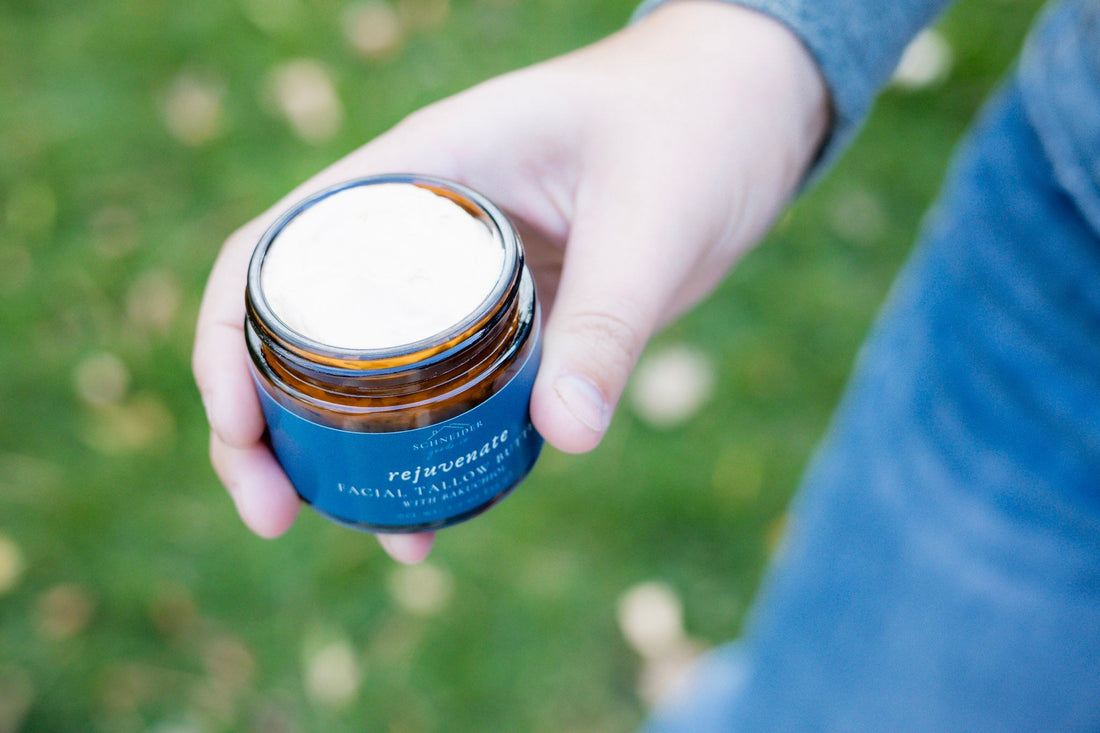
Skincare 101
As we’ve researched and developed our products, we’ve learned a lot about skincare. Here are some basic principles and realizations we’ve had, to help you understand it better and find the right products for your skin!
Becoming an educated consumer in this area is crucial, for a couple reasons. First, the skincare industry in the United States is surprisingly unregulated. Companies are generally responsible for testing and ensuring the safety of their ingredients and formulations. This can become a problem on both sides of the natural skincare realm - for example, manufacturers can use harmful chemicals and synthetics with little restriction, and companies offering nontoxic options may create products that lack sufficient lab testing and preservation systems to kill harmful bacteria in their products.
It’s also important to become educated so that you can choose the correct products for your skin. Skincare is NOT one-size-fits-all! Even tallow is not a miracle product (despite what social media influencers and tallow business advertisements claim). It works very well for many people, but it also might not be the best fit for others. We offer sample sizes of our tallow because we want you to be able to test it on your own skin and see how it responds. If you’re trying it and wondering how to use it for the best results, read this post.
Why Chemicals in Skincare?
Remember that chemicals and synthetic ingredients were developed for a reason. Before diving into the world of skincare, we were under the impression that chemicals are just thrown into products to cut costs or add filler. We heard insinuations that companies know they are hurting your health and don’t care. If you’ve listened to people talking about toxins, clean beauty, or “greenwashing”, you may have gotten the same fear-based messaging. We’ve learned, though, that chemicals do add performance benefits to products! For example, humectants draw moisture from the atmosphere into the skin, preservatives kill bacteria to enable a shelf life long enough to use the product, and emulsifiers stabilize the combination of water and oils so they don’t separate. Some chemicals make products easier to wash off, and some enhance the performance of the active ingredients. On the flip side, their safety is more difficult to determine and feel good about. As we’ve seen in the history of skincare (and many other) products, ingredients can seem safe but later research shows they are actually harmful or toxic.
When considering your skincare options, you’ll have to weigh the ingredients and performance against your personal criteria and choose the right balance for you. Some people may want to avoid all chemicals and don’t care about the details of performance, while some may care more about having the highest functioning product and accept some synthetic ingredients. Unfortunately you usually can’t have it all!
Skin Barrier
We’ve all heard that our skin is our largest organ. It’s made up of three layers: epidermis (outer layer), dermis (middle layer), and subcutaneous fatty layer. The part of our skin we touch is called the stratum corneum, and it’s your body’s first line of protection against UV rays, infection, dehydration, and toxins. The stratum corneum is made up of keratinized cells embedded in a lipid matrix.
The goal of skincare products is to make your skin barrier as healthy as it can be, so that it can properly keep water in and gunk out. A healthy barrier will be the best line of defense against the toxins we are inevitably exposed to in every area of our lives. An unhealthy skin barrier can cause dry skin, itchy or inflamed skin, lack of elasticity, wrinkles, discoloration, and infections.
As you consider which products to incorporate into your skincare routine, the most important are a cleanser and a moisturizer. You want to make sure you are cleaning your face well, so that nothing gets trapped under your moisturizer. Apply a moisturizer while your face is still damp, or spray it with rose water or another hydrosol, so that it can hold that water inside your skin barrier. Tallow is both an emollient and an occlusive, which means it softens your skin and it creates a barrier to reduce the amount of water loss.
Water in Skincare
Water breeds life, including bacteria, mold, fungi, etc. This means that when oils (like tallow) are combined with water, they become a potential breeding ground for harmful microorganisms. It’s similar to food - you wouldn’t leave it on the counter (or even in the refrigerator) for weeks and expect it to be safe to eat. Preservatives are added to skincare products because they block the growth of these organisms and make it possible to have a shelf-stable product that lasts longer than a few days.
However, anhydrous products are the exception! These are formulations that do not contain water or ingredients with water (aloe, glycerin, honey, etc), and therefore won’t grow bacteria unless water is introduced. Our tallow products fall into this category, which is why we caution against using wet fingers when scooping it out.
We hope this helped you understand skincare and non-toxic products better! Let us know if you have questions or suggestions for future topics.
